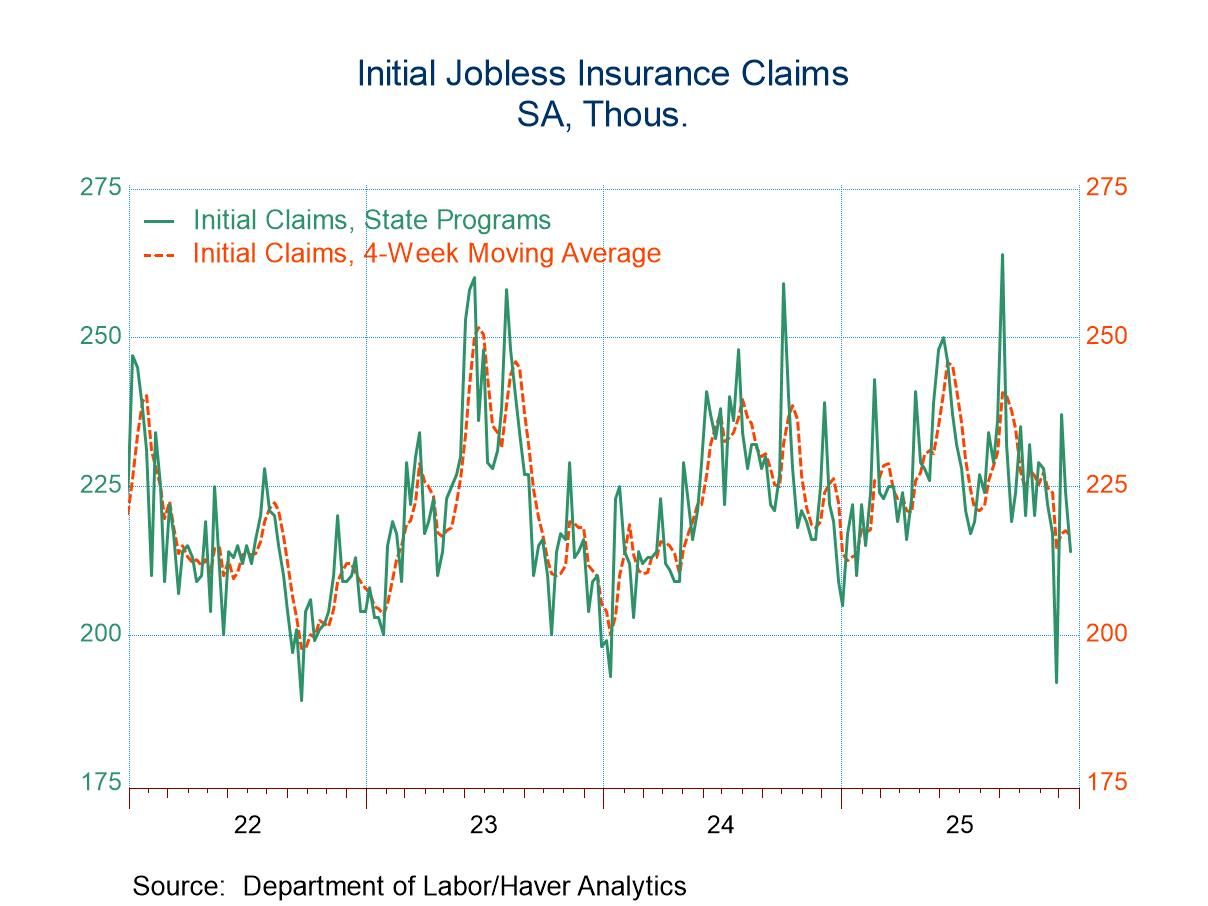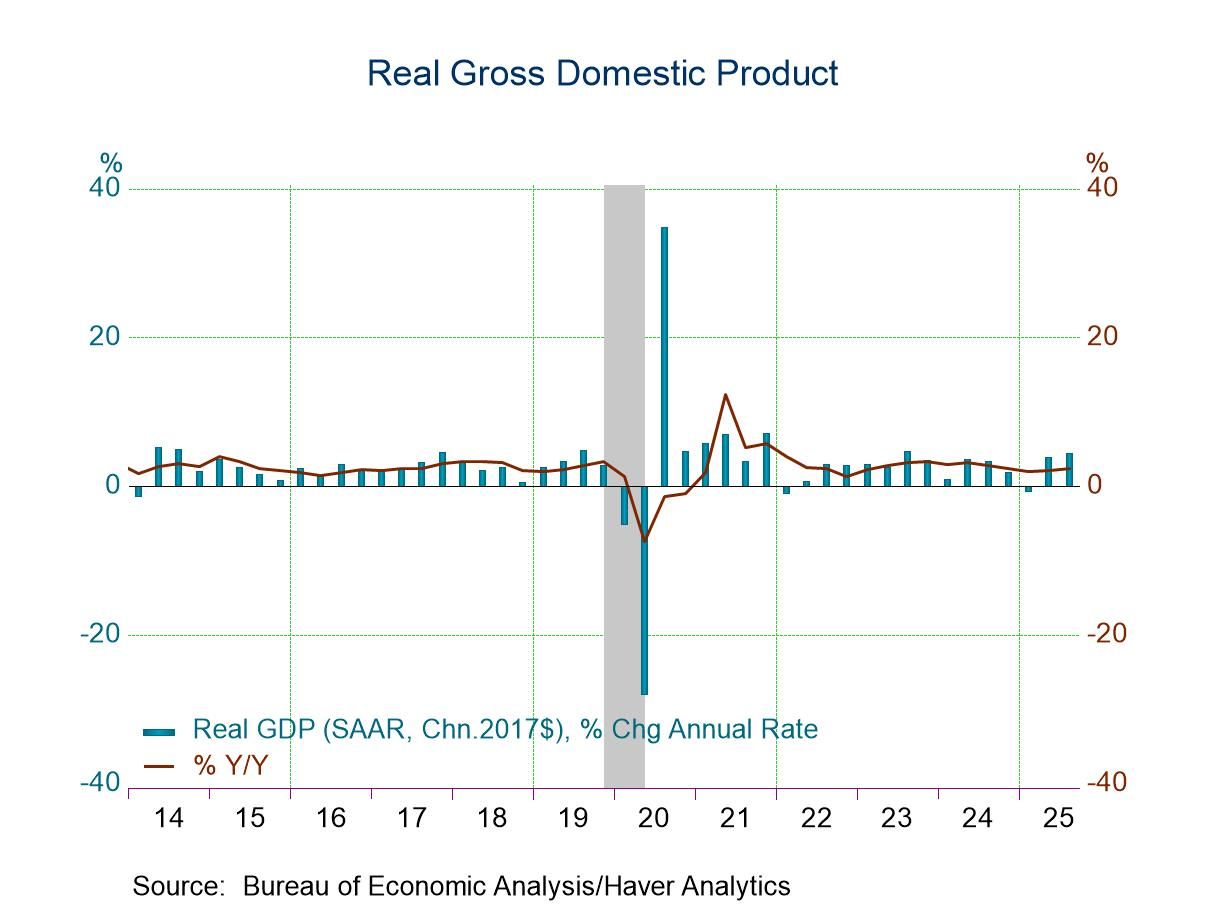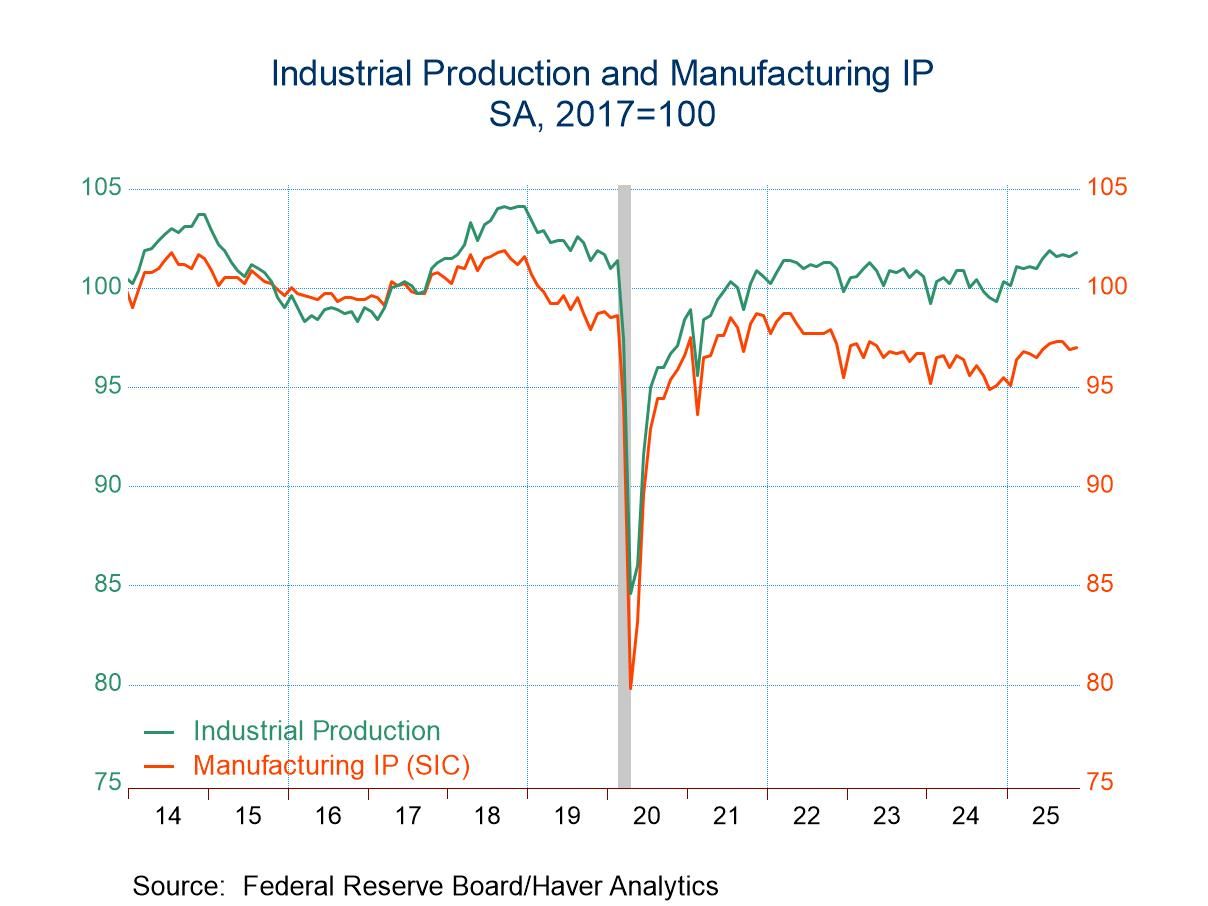 Global| Jun 12 2018
Global| Jun 12 2018U.S. CPI Increases Steadily M/M; Core Prices Pick Up
by:Tom Moeller
|in:Economy in Brief
Summary
Consumer prices increased 0.2% (2.8% y/y) during May for the second straight month. The gain matched expectations in the Action Economics Forecast Survey. The CPI excluding food & energy rose an expected 0.2% (2.2% y/y) after a 0.1% [...]
Consumer prices increased 0.2% (2.8% y/y) during May for the second straight month. The gain matched expectations in the Action Economics Forecast Survey. The CPI excluding food & energy rose an expected 0.2% (2.2% y/y) after a 0.1% rise.
Last month's increase was led by a 0.9% rise (11.7% y/y) in energy prices which followed a 1.4% strengthening during April. Gasoline prices increased 1.7% (21.8% y/y) after a 3.0% rise, but fuel oil costs fell 0.7% (+25.3% y/y) on the heels of a 2.7% increase. Electricity prices ticked 0.1% higher (1.0% y/y) after a 0.6% decline, but natural gas prices fell 0.6% (-0.8% y/y), off for the third consecutive month.
Goods prices excluding food & energy slipped 0.1% for the third straight month. The 0.3% y/y decline in prices, however, moderated from the 1.0% y/y drop in October. Prices for used cars & trucks fell 0.9% (-1.7% y/y), down for the fourth straight month. New vehicle prices increased 0.3% (-1.1% y/y) after declines in three of the prior four months. Recreation product prices fell 0.7% (-3.3% y/y) as prices for video & audio products dropped 0.8% for the third straight month (-12.6% y/y). Furniture & bedding costs were off 0.3% (-0.1% y/y), but appliance prices rose 0.3% (-0.1% y/y) following two months of strong increase. Medical care product prices surged 1.3% (2.7% y/y) after a slight dip, but apparel prices held steady (-1.4% y/y) following a 0.3% rise.
Services prices less energy increased 0.3% (3.0% y/y) after a 0.2% rise. Recreation services led the gain with a 0.4% rise (+1.8% y/y) which followed two months of decline. Education & communication services prices also improved 0.4% (0.7% y/y) after declining during each of the prior four months. Shelter prices rose 0.3% (3.5% y/y) for the second straight month reflecting a 0.3% increase (3.6% y/y) in rents of primary residences. The owners' equivalent rent of primary residences increased 0.3% (3.4% y/y) for the third straight month. Medical care services prices eased 0.1% (+2.3% y/y) after a 0.2% gain, but public transportation costs fell 1.2% (-2.8% y/y) led by a 1.9% drop (-6.6% y/y) in airline fares.
Food prices held steady last month (1.2% y/y) after increasing 0.3% in April. Fruit & vegetable prices eased 0.3% (-0.4% y/y) after a 1.0% jump. Meat prices declined 0.7% (+1.4% y/y). Egg prices fell 3.3%, but were up by nearly one-quarter y/y. Dairy & related product prices eased 0.1% (-0.6% y/y), after a 0.4% rise. Cereal & bakery product prices held steady (-0.2% y/y), following a 0.2% dip. Nonalchoholic beverage prices rose 0.4% (-1.3% y/y), after a 0.6% decline.
The consumer price data can be found in Haver's USECON database with additional detail in CPIDATA. The Action Economics survey figure is in the AS1REPNA database.
| Consumer Price Index, All Urban Consumers (% chg) | May | Apr | Mar | May Y/Y | 2017 | 2016 | 2015 |
|---|---|---|---|---|---|---|---|
| Total | 0.2 | 0.2 | -0.1 | 2.8 | 2.1 | 1.3 | 0.1 |
| Total less Food & Energy | 0.2 | 0.1 | 0.2 | 2.2 | 1.8 | 2.2 | 1.8 |
| Goods less Food & Energy | -0.1 | -0.1 | -0.1 | -0.3 | -0.7 | -0.5 | -0.5 |
| Services less Energy | 0.3 | 0.2 | 0.3 | 3.0 | 2.7 | 3.1 | 2.6 |
| Food | 0.0 | 0.3 | 0.1 | 1.2 | 0.9 | 0.3 | 1.9 |
| Energy | 0.9 | 1.4 | -2.8 | 11.7 | 7.9 | -6.6 | -16.7 |
U.S. Small Businesses Optimism Strengthens Dramatically
by Tom Moeller June 12, 2018
The National Federation of Independent Business (NFIB) indicated that its Small Business Optimism Index increased to 107.8 during May following two months near 104.8. It was the strongest reading since the third quarter of 1983.
A record 34% of firms indicated that now was a good time to expand the business. A stronger 30% of firms planned to make capital outlays, the most in nine months. A higher 37% of firms expected the economy to improve, the most in three months; but that remained down below the 2017 average of 39%. A greatly increased 31% of firms were expecting higher real sales, the most in six months. Eighteen percent of businesses were planning to increase employment. That was up m/m but still well below the 24% November high. Meanwhile, a lessened 48% indicated that there were few or no qualified candidates for job openings, down from the December high of 54%.
Pricing pressure strengthened as a net 19% of firms were raising average selling prices, the most since September 2008. Twenty-six percent of firms were planning to raise prices, also a ten year high. A record 35% of firms increased worker compensation, but a lower 20% of businesses were planning to raise compensation.
Finding the financial resources to expand business remained relatively easy. A stable five percent of businesses reported difficulties in obtaining credit, up from three percent during the first quarter.
This survey inquires about problems facing small business. The most pressing problem in May continued to be labor quality as a near-record 23% indicated a problem, up from four percent in 2010. A lower six percent of firms reported the cost of labor as the most significant problem. Government requirements became much less worrisome at 13%, down from 22% in 2015. A still-low 18% indicated that taxes were the largest problem, down from a December 2014 high of 27%. Competition from large businesses remained high at 10%, and insurance costs/availability worried a lessened 10%. Poor sales remained at an expansion low of 8% while financial & interest rate problems (1%) remained negligible. Price inflation problems strengthened to a six month high of three percent reporting a problem.
Roughly 24 million small businesses exist in the U.S. and they create 80% of all new jobs. The index is based 1986=100. The typical NFIB member employs 10 people and reports gross sales of about $500,000 a year.
The NFIB figures can be found in Haver's SURVEYS database.
| National Federation of Independent Business (SA, Net % of Firms) | May | Apr | Mar | May'17 | 2017 | 2016 | 2015 |
|---|---|---|---|---|---|---|---|
| Small Business Optimism Index (1986=100) | 107.8 | 104.8 | 104.7 | 104.5 | 104.9 | 95.3 | 96.1 |
| Firms Expecting Economy to Improve | 37 | 30 | 32 | 39 | 39 | -5 | -5 |
| Firms Expecting Higher Real Sales | 31 | 21 | 20 | 22 | 23 | 5 | 8 |
| Firms Reporting Now Is a Good Time to Expand the Business | 34 | 27 | 28 | 23 | 23 | 10 | 12 |
| Firms Planning to Increase Employment | 18 | 16 | 20 | 18 | 18 | 11 | 12 |
| Firms With Few or No Qualified Applicants for Job Openings (%) | 48 | 50 | 47 | 51 | 49 | 46 | 46 |
| Firms Reporting That Credit Was Harder to Get | 5 | 5 | 4 | 3 | 4 | 5 | 4 |
| Firms Raising Average Selling Prices | 19 | 14 | 16 | 7 | 7 | 0 | 2 |
| Firms Raising Worker Compensation | 35 | 33 | 33 | 28 | 27 | 24 | 23 |
U.S. Government Budget Deficit Continues to Increase Y/Y
by Tom Moeller June 12, 2018
The U.S. Treasury Department reported that the federal government ran a $146.8 billion budget deficit during May 2018. That compared to a $88.4 billion deficit during May 2017. A $119.5 billion had been expected in the Action Economics Forecast Survey. During the first eight months of fiscal year 2018, the government's budget deficit totaled $532.2 billion, up 22.9% versus $432.9 billion in the first eight months of FY'17.
Net revenues rose 2.6% y/y so far in FY'18 after a 1.5% increase during all of last fiscal year. Individual income taxes increased 9.0% y/y following a 2.7% rise during all of last fiscal year. The increase in social insurance receipts eased to 2.1% y/y from 4.2% last year, and excise taxes improved 11.5% y/y and reversed last year's 11.8% decline. The rate of decline in corporate income taxes quickened to -25.4% y/y with the corporate income tax cut, after taxes fell 0.8% during all of last fiscal year.
Government spending increased 5.9% y/y so far in FY'18 compared to 3.3% growth during all of FY'17. National defense spending rose 5.2% y/y after slight increases during the last two fiscal years. Health insurance spending grew a steady 4.1% y/y, while Medicare outlays increased an accelerated 2.5% y/y. With the lower unemployment rate, income security payments slipped 0.6% y/y after their 2.1% FY'17 decline. Social Security payments rose an accelerated 4.3% y/y. Interest payments gained 17.5% y/y so far in FY'18 after increasing 9.2% last fiscal year.
Haver's data on Federal Government outlays and receipts are contained in USECON. Considerable detail is given in the separate GOVFIN database. The Action Economics Forecast Survey numbers are in the AS1REPNA database.
| United States Government Finance | May 2018 | FY'17 | FY'16 | FY'15 | FY'14 | FY'13 | |
|---|---|---|---|---|---|---|---|
| Budget Balance (Billions) | -- | $-146.8 | $-665.7 | $-585.6 | $-439.1 | $-483.4 | $-680.2 |
| As a percent of GDP | -- | -- | 3.5% | 3.2% | 2.5% | 2.8% | 4.1% |
| % of Total | |||||||
| Net Revenues (Fiscal Year YTD 2018, Y/Y % Change) | 100 | 2.6% | 1.5% | 0.6% | 7.6% | 8.9% | 13.3% |
| Individual Income Taxes | 47 | 9.0 | 2.7 | 0.3 | 10.5 | 5.9 | 16.3 |
| Corporate Income Taxes | 9 | -25.4 | -0.8 | -12.9 | 7.2 | 17.3 | 12.9 |
| Social Insurance Taxes | 34 | 2.1 | 4.2 | 4.7 | 4.1 | 8.0 | 12.1 |
| Excise Taxes | 3 | 11.5 | -11.8 | -3.3 | 5.3 | 11.1 | 6.3 |
| Net Outlays (Fiscal Year 2017 YTD, Y/Y % Change) | 100 | 5.9 | 3.3 | 4.5 | 5.3 | 1.4 | -2.4 |
| National Defense | 15 | 5.2 | 0.8 | 0.7 | -2.3 | -4.7 | -6.3 |
| Health | 15 | 4.1 | 4.1 | 6.2 | 17.8 | 14.3 | 3.3 |
| Medicare | 15 | 2.5 | 0.6 | 8.7 | 6.7 | 2.8 | 5.5 |
| Income Security | 13 | -0.6 | -2.1 | 1.0 | -0.9 | -4.3 | -1.1 |
| Social Security | 24 | 4.3 | 3.1 | 3.2 | 4.4 | 4.5 | 5.2 |
| Veterans Benefits & Services | 4 | 6.4 | 1.2 | 9.3 | 6.8 | 7.7 | 11.5 |
| Education, Training, Employment & Social Services | 4 | 6.5 | 31.6 | -10.2 | 34.7 | 25.9 | -21.9 |
| Interest | 7 | 17.5 | 9.2 | 7.8 | -1.8 | 2.8 | 0.4 |
Tom Moeller
AuthorMore in Author Profile »Prior to joining Haver Analytics in 2000, Mr. Moeller worked as the Economist at Chancellor Capital Management from 1985 to 1999. There, he developed comprehensive economic forecasts and interpreted economic data for equity and fixed income portfolio managers. Also at Chancellor, Mr. Moeller worked as an equity analyst and was responsible for researching and rating companies in the economically sensitive automobile and housing industries for investment in Chancellor’s equity portfolio. Prior to joining Chancellor, Mr. Moeller was an Economist at Citibank from 1979 to 1984. He also analyzed pricing behavior in the metals industry for the Council on Wage and Price Stability in Washington, D.C. In 1999, Mr. Moeller received the award for most accurate forecast from the Forecasters' Club of New York. From 1990 to 1992 he was President of the New York Association for Business Economists. Mr. Moeller earned an M.B.A. in Finance from Fordham University, where he graduated in 1987. He holds a Bachelor of Arts in Economics from George Washington University.






